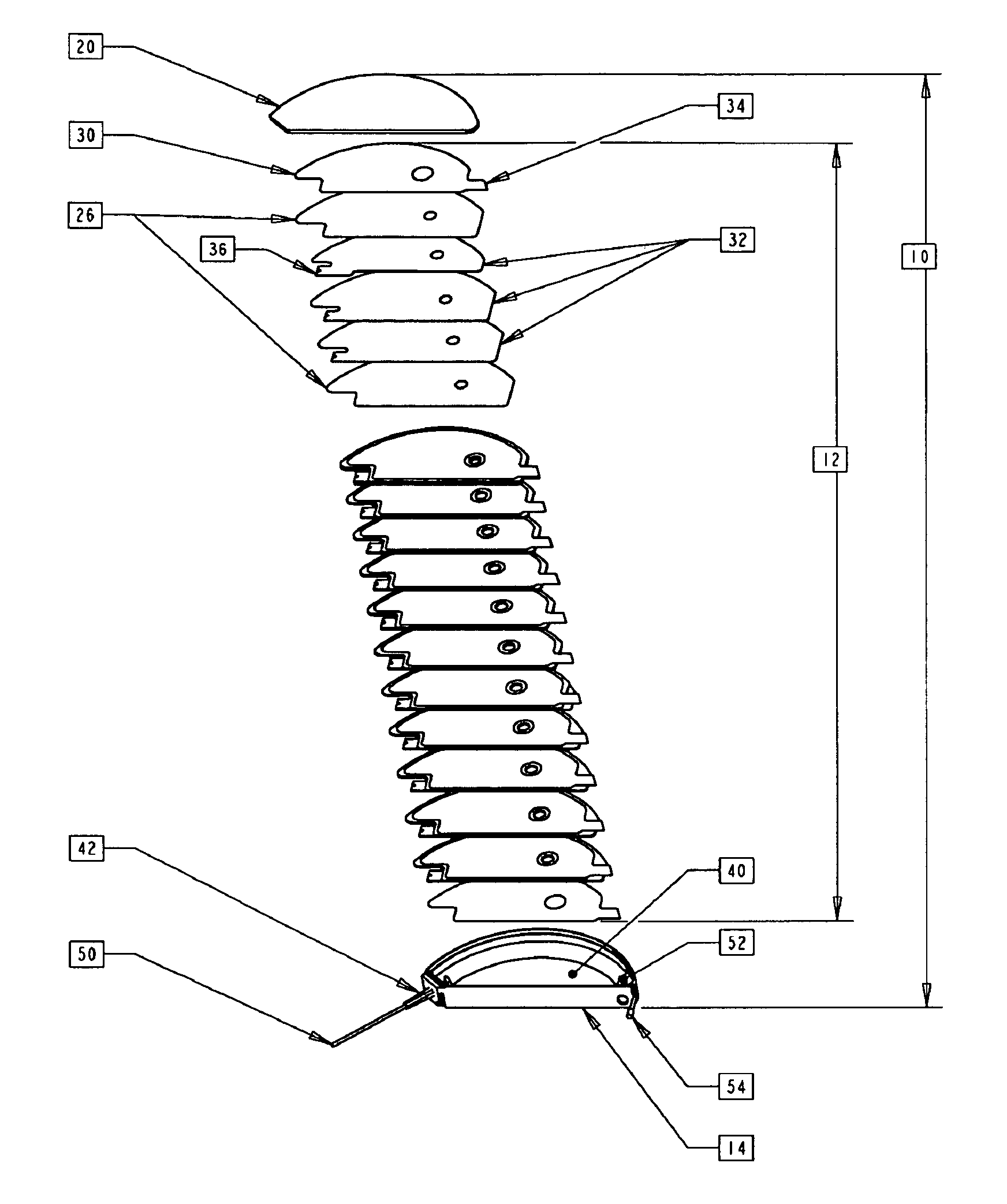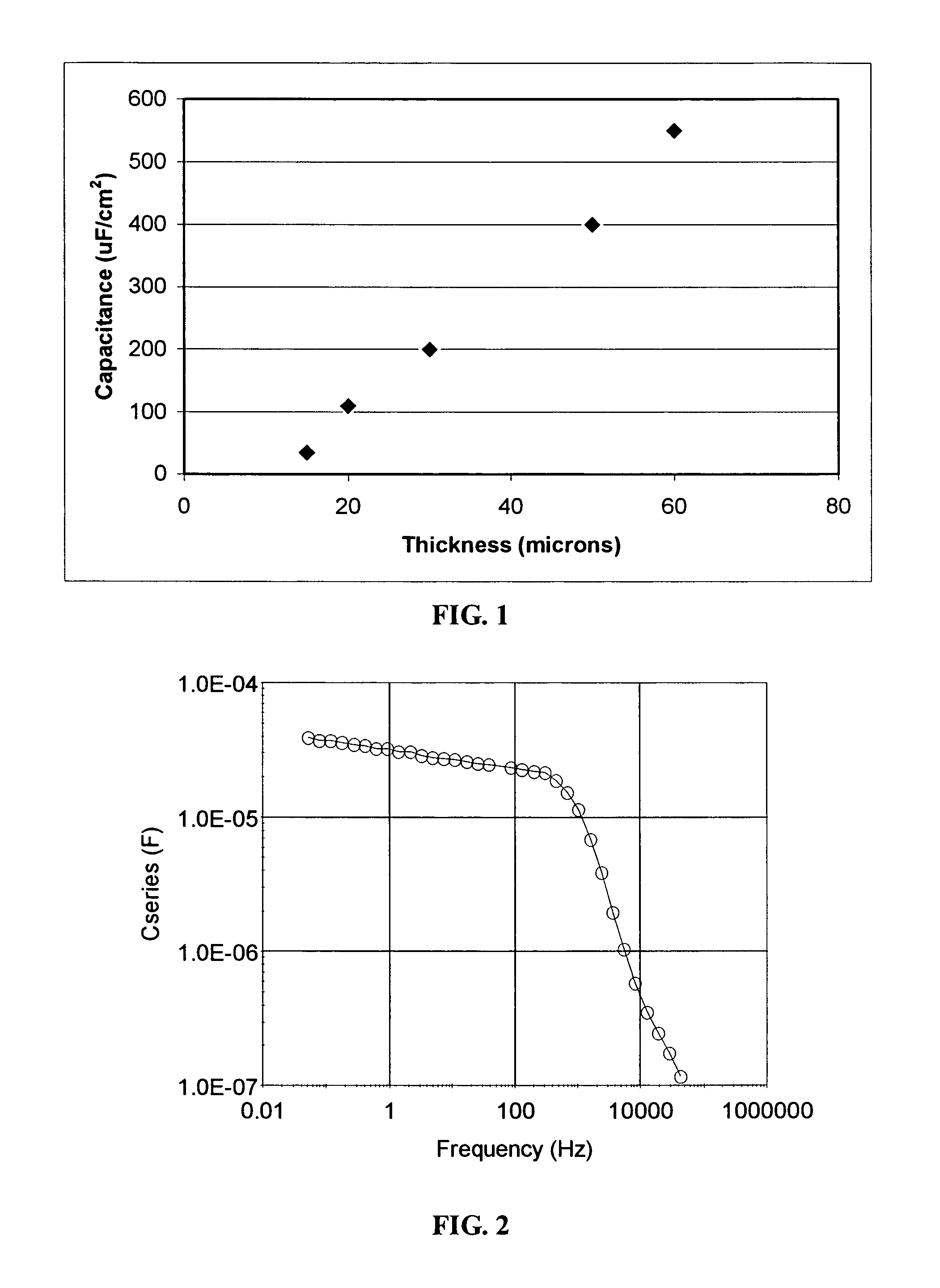Electrolytic capacitors with alternate cathode materials for use in pulse discharge applications
a capacitor and cathode technology, applied in the field of cathode electrodes within electrolytic capacitors, can solve the problems of consuming electrolyte, reducing capacitor performance, and reducing capacitor performance, so as to avoid capacitor swelling, reduce manufacturing costs, and simple water and alcohol rinse
- Summary
- Abstract
- Description
- Claims
- Application Information
AI Technical Summary
Benefits of technology
Problems solved by technology
Method used
Image
Examples
example 1
[0067]Finished capacitors according to the present invention were constructed with several different raw metals as cathode material. Grade 1 titanium, grade 2 titanium and nickel foils were all used as cathode material. Each metal sample was pretreated with an alcohol and water rinse before being used in a capacitor. As a control, capacitors were also constructed with Becromal Kappa 30B cathode material.
[0068]Each capacitor was impregnated with an ammonium azelate and boric acid in ethylene glycol electrolyte and then tested. The total delivered energy, stored energy, and ESR were measured for each capacitor tested. Four capacitors were constructed and measured for each type of cathode material. Table 1, below, displays the average of these four measurements for each type of capacitor.
[0069]
TABLE 1Total DeliveredType of CathodeEnergy (J)ESR (Ω)Stored Energy (J)Kappa 30B (control)15.651.0617.87Grade 1 Titanium15.501.0617.60Grade 2 Titanium15.530.9917.68Nickel15.620.9917.87
[0070]These...
example 2
[0073]Slide capacitors were constructed with a four anode per layer stack, six layers of 0.25 mil Kraft paper in 1.0 g / cc density (available from MEDielectrics, Inc. of Mt. Holly Springs, Pa.), two grade 2 titanium cathode foils (nominal thickness 0.001″), an electrolyte and a platinum wire separated from a cathode by one sheet of paper. The slide capacitors were built as follows: glass slide—titanium cathode—three layers of Kraft paper—welded four anode stack—two layers of Kraft paper—platinum wire—one layer Kraft paper—titanium cathode—glass slide. The platinum wire served to measure the pulse discharge voltage at the cathode.
[0074]The slide capacitors were vacuum impregnated with one of the following electrolytes: (a) ammonium azelate and boric acid in ethylene glycol (hereinafter “Electrolyte A”), (b) ammonium azelate and boric acid in ethylene glycol with 1% o-nitroanisole (hereinafter “Electrolyte B”), (c) ammonium azelate and boric acid in ethylene glycol with 1% 3′-nitroacet...
example 3
[0081]To determine if placement of the platinum wire in the slide capacitors of Example 2 impacted the discharge voltage measured by the oscilloscope, several slide capacitors with two platinum wires were constructed. These slide capacitors contained two platinum wires side by side, between the same two layers of paper, at different positions. Each platinum wire was hooked to a separate oscilloscope probe tip. Two oscilloscope channels were used to measure the pulse discharge voltage at each platinum wire simultaneously.
[0082]This test revealed differences in the measured voltage at the two leads. In a slide capacitor impregnated with Electrolyte C the reported pulse discharge voltages of the two leads varied by about 2.5V after the first pulse. After repeated pulsing, the disparity between the two voltage measurements increased. After 20 pulses, the reported discharge voltage of one lead was approximately five volts higher than that of the other lead. In a slide capacitor impregnat...
PUM
| Property | Measurement | Unit |
|---|---|---|
| thick | aaaaa | aaaaa |
| thick | aaaaa | aaaaa |
| thick | aaaaa | aaaaa |
Abstract
Description
Claims
Application Information
 Login to View More
Login to View More - R&D
- Intellectual Property
- Life Sciences
- Materials
- Tech Scout
- Unparalleled Data Quality
- Higher Quality Content
- 60% Fewer Hallucinations
Browse by: Latest US Patents, China's latest patents, Technical Efficacy Thesaurus, Application Domain, Technology Topic, Popular Technical Reports.
© 2025 PatSnap. All rights reserved.Legal|Privacy policy|Modern Slavery Act Transparency Statement|Sitemap|About US| Contact US: help@patsnap.com



